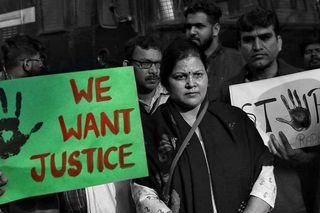
Why the Police Killing the Hyderabad Rape Accused Isn’t Justice
150 years ago, society moved from executing criminals to trying and imprisoning them for a reason.

3:30 a.m. is an odd time for the police to try and recreate a crime scene — it’s dark; it’s misty in December — but the Hyderabad Police were hard at work then. After all, they had promised the parents of the 26-year-old victim of a recent gang rape and murder case that they’d take immediate action.
In the early hours of Friday morning, they took the four accused in the case to the scene of the crime on the Hyderabad-Bengaluru national highway. A few hours later, news broke that police had fatally shot all four men who had reportedly tried to escape.
“Well done, boys,” Shesh Paul Vaid, former director-general of police of the erstwhile state of Jammu and Kashmir, said in a tweet. “This is the way to deal with rapists,” BJP leader Kapil Mishra said in another. From Chief Ministers to Members of Parliament to activists fighting for women’s rights — people hailed the encounter as justice being served. Baba Ramdev, a self-proclaimed godman who has lakhs of people hanging onto his every word, said that in cases as heinous as this, all police officials should adopt this method of delivering justice — “on the spot.” Social media has been aflutter with praise for the police, while people in Hyderabad have been showering rose petals on the officials who killed the bad, bad men.
A few, woefully outnumbered by the majority, have dared ask what if the four men who were shot were innocent. But here’s a thought: what if they were guilty? It’s not justice either way — it hasn’t been for a few thousand years now.
The collective sigh of relief is understandable — Indian media has scripted the case gorily enough to have people baying for the blood of the accused. But in our search for catharsis, amid our frustrations with a broken system, and our episodic hatred for the deeply misogynistic society that India is, our idea of justice, it seems, is regressing back by 4,000 years.
“An eye for an eye; a tooth for a tooth” was the retributive principle that underlined legal codes in the earliest known system of law established in 18th century BC Babylon; death and torture were frequently employed to deal with lawbreakers. Rome fell 2,200 years later; then Europe was submerged in what is known as the Dark Ages. The Church, in power at this time, continued to mete death and torture as modes of justice — and escalated this retributive model with the Inquisition in the 13th century, during which members of the Church tortured and killed thousands of Protestants, Jews and Muslims for heresy — a crime, per the Church’s laws.
The secrecy of the interrogations, the complete isolation of the condemned from the society and the dedication of the inquisitors in righting wrong were the key elements of the Church’s model of justice that lasted for roughly 700 years — elements that mirror the so-called justice that has been served in the Hyderabad case with the recent police encounter.
Related on The Swaddle:
What It Will Take to End Gang Rapes in India
We don’t know what really happened on Friday morning on that highway — why weren’t the police adequately staffed when they took the accused out to the crime scene at dawn? Why were the accused not handcuffed and, if they were, how did they snatch a weapon from the police since they were unarmed? Why didn’t the police shoot to injure and intercept the accused instead of killing them? The whole incident is shrouded in secrecy, as almost all police encounters in India are — and seems more 13th century than 21st.
The findings of a recent survey on the status of policing in India highlights a similar dedication among police officers to outmoded retribution: of nearly 12,000 police officers, nearly 20% said it was better to kill dangerous criminals than have a trial. Nearly 75% opted for violence towards criminals, and 37% advocated punishment in place of legal trial for minor offenses. This mindset is reflected in the Indian police force’s history and culture of excessive use of force and staging fake encounters to short-circuit the due process of law.
But there’s a reason democratic societies’ criminal justice systems have moved, 150 years ago, from extrajudicial killings, public executions, and torture to trying and imprisoning convicted criminals.It was only in the 19th century, that a wave of humanitarian reform that had been building up in Europe for some time caused a massive shift in the way criminal justice systems were designed. Activists, philosophers, sociologists, and state officials argued that capital punishment was a violation of human rights; that death and torture did not serve as a deterrent to crime and only encouraged and normalized violence; and, that justice should be rehabilitationist not retributive — that is, those who break the law should be removed from society, and imprisoned humanely, not killed by the State. A major liberalizing influence in this direction was a book called On Crimes and Punishments (1764) by Italian political philosopher Cesare Beccaria, which drew attention to injustices within Europe’s criminal court systems and the appalling condition of its prisons and made the case to move away from more severe forms of justice like death and torture.
He writes, “the intent of punishments is not to torment a sentient being, nor to undo a crime already committed. …. Instead of being influenced by passion, such institutions should be the cool moderator of the passions of individuals. Can the groans of a tortured wretch bring back the time past, or reverse the crime he has committed? The end of punishment, therefore, is no other than to prevent the criminal from doing further injury to society, and to prevent others from committing the same offense. Such punishments, therefore, and such a manner of inflicting them ought to be chosen in a way that will make the strongest and most lasting impressions on the minds of others, with the least torment to the body of the criminal.”
Reforms were passed in Europe and England took this new idea of justice to its colonies, including India, which until then, under the Mughal Empire, also had a retributive justice system wherein the Emperor’s army and officials killed and tortured criminals as protocol. With the establishment of a democratic, independent India 300 years later, our criminal justice system became even more concerned with human rights (having suffered egregious violations under colonialism), and our idea of justice moved one step further: from a rehabilitationist one to a reformative one that believed in the course-correction for criminals over and above their humane imprisonment. The Constitution of India established that all persons have the right to life, dignity, and fair trial in courts — including criminals or accused awaiting judgment.
Several research studies to date have proved that this kind of system is more effective than capital punishment in deterring crime, further strengthening the case against retributive justice and for the justice system that India — and all democratic societies — have today.
Related on The Swaddle:
Know Your Rights: Dealing With Law Enforcement as a Woman
We can’t go back to the Dark Ages; we’ve covered too much ground in our progress. We know now that criminals — rapists — are not born evil, they’re a product of social conditioning within deeply unequal and violent societies. We also know that this conditioning can be unlearned and that reforming even violent rapists is very much possible. Rape is not just a crime — it’s a crime produced by a pervasive rape culture in our society which is a bigger battle than killing a few men, and if the Inquisition taught us anything it’s the dangers of giving a few the power to kill. We also know that death as a punishment for rape only incentivizes rapists to kill the victim after raping her to destroy evidence — and does not lead to fewer men raping.
Celebrating the encounter killings of the accused in the Hyderabad case is taking several staggering steps backward — if the men were, in fact, guilty, then death is not what we should wish upon them — not death via a capital punishment law, and especially not death via extrajudicial killings by the Indian police.
Just because our legal and judicial systems are broken, understaffed and made up of underpaid, overworked, and poorly trained people does not mean we abandon the system or go above it. It means we focus even more energy into fixing and improving our systems of reformative criminal justice — there’s a reason it exists as it does, in its ideal form, after centuries of reform with human rights as the main focus.
With this police encounter, now we have no way of knowing whether the four accused were innocent or guilty. If they were innocent, then the police framed four citizens of the country, jailed them, and shot them to showcase swift action, committing murder to close the case. If the four men were guilty, the encounter is antithetical to justice even more. Death is an easy way out for them; the men should have been tried, found guilty and thrown in jail for the rest of their lives, with their mobility and rights restricted, pushed to introspect about their actions and mindset while going through intense reformative programs.
After all, what’s the bigger plan here with this “eye for an eye” idea of justice? Will those who are celebrating the extrajudicial killing of the four men also stand for the death of all the men who rape a woman in this billion-strong country every 20 minutes — 95% of whom are family members, friends, colleagues, or someone else known to the victim? And what of those who are falsely accused — should the State shoot them as well without a trial?
We have come a long way from Babylon; it may be time to abandon this primitive, retributive idea of justice as a relic from a less civilized period of human history.
Pallavi Prasad is The Swaddle's Features Editor. When she isn't fighting for gender justice and being righteous, you can find her dabbling in street and sports photography, reading philosophy, drowning in green tea, and procrastinating on doing the dishes.
Related


Study: Kids’ Gender Identity Is Just as Strong Whether They’re Transgender or Cisgender
